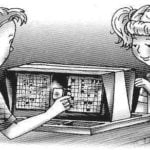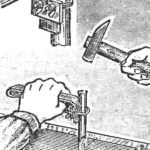In the club of young technicians in the Novosibirsk Academic Town, in the laboratory of experimental modeling and design, off-road vehicles called “Marsh” tricycles have been designed and built.
The tricycle features a modern compact open-body design and a powerful IZH-56 engine installed at the rear above the vehicle’s leading axle. The engine is equipped with an electric starter and a direct current generator for recharging the battery, and it has forced cylinder cooling. Lockable rear wheels allow the tricycle to easily overcome challenging road sections. The body includes two spacious trunks – one closed located above the front wheel, and one open at the back, above the engine. The front trunk contains two side compartments for two 15-liter gasoline canisters each. The rear trunk can carry a load of up to 70 kg or accommodate an additional passenger.
The road is illuminated at night by a steering wheel-controlled headlight with both low and high beams, and two small headlights mounted at the front of the body. The small headlights effectively illuminate the road nearby without blinding oncoming drivers. Six turn signals located on the sides of the tricycle are visible from all sides of the vehicle. The rearview mirror, mounted on the left side of the handlebar, allows the driver to monitor the traffic behind. A six-volt EST-70 PMSZ (battery brand) battery is installed under the driver’s longitudinal seat. The instrument panel is equipped with a speedometer, a switch for low and high beams, a toggle switch for turning off the dip light and turn signals, a charge indicator light, a horn button, and a starter button. There are two pedals on the vehicle floor: left for gear shifting and right for rear wheel brakes.
The levers for the front brake, clutch, and gas handles are located on the motorcycle-type handlebar. In the summer, the tricycles successfully completed a two-hundred-kilometer test drive under challenging road conditions, proving to be durable touring vehicles. The route included forest, dirt, and sandy roads, as well as complex terrain with steep ascents and descents. The young testers were satisfied with their vehicles.
The construction of the vehicle is well illustrated by the provided drawings. The tricycle’s foundation is a frame on which all the components of the chassis and body are installed.

The frame structure is shown in Figure 1. Its front part comes from the cargo scooter “Tula-200,” with the brackets for securing the driver’s seat and the rear part of the engine mount cut off up to the transverse beam. Ears are welded to the ends of the transverse beam, which are necessary for installing the pendulum frame of the rear axle and attaching the engine. The pendulum suspension frame is connected to the ears of the main frame with steel bushings through rubber bushings and has free up-and-down movement. The rear frame suspension structure is visible in Figure 1. A bracket for mounting shock absorbers is welded above the ears. Two spring shock absorbers with hydraulic dampers from the front suspension of the “Vyatka” scooter are installed on the tricycle.
The IZH-56 engine with forced cooling is mounted on the pendulum frame. The transmission from the engine to the rear axle is carried out by a roller chain, and a driven sprocket with 39 teeth is installed on the axle. The axle is solid with a lockable clutch, which is located on the right side of the axle in the direction of the vehicle’s movement. The clutch is engaged only on difficult road sections. The foot brake acts on two rear wheels, and the brake pedal is located under the right foot on the body floor. The brake drive is mechanical and is actuated by rods.
The front fork is borrowed from the “Tula-200” scooter and reinforced with welded ribs.
The fuel tank is installed under the cover of the rear tilting trunk. When the trunk is opened, there is free access to the gas tank, engine, and its components: the carburetor, ignition system, and roller chain tensioner block.

The body (Figure 2) is of an open type, monolithic, made of 0.5 mm thick steel. The front shield and side half-boards protect the driver from dust and mud. The engine is covered with a hood, the cover of which serves as an open trunk, and if necessary — an additional seat for a passenger. A spare wheel is attached to the rear wall of the hood, stop signals, turn signals, and an illuminated panel for the license plate are located there. The driver’s seat is longitudinally positioned in the middle of the tricycle. It is padded with foam and covered with artificial leather.
The body is attached with four bolts to the frame and can be removed if necessary. It is painted in two colors: the upper part is light green, the lower part is painted in black, with a white stripe in the middle bordered by thin black lines. The name “MARSH” is written on the stripe, which is deciphered as “MICROCAR DEVELOPED BY SCHOOL STUDENTS.”

TECHNICAL DATA OF THE ‘MARSH’ TRICYCLE
Three-wheeled motorcycle-type chassis. Open monolithic body. Two-stroke engine, working volume 349 cm³. Motorcycle control.
Dimensions in mm: wheelbase — 1410, track — 600, ground clearance — 240, height — 1000, width — 760, length — 2140; model B-2 wheels, Ø 450 mm, direct current electrical equipment — 6 V, maximum speed — 65 km/h; load capacity — 180 kg; dry weight — 260 kg.
M. LARKIN



